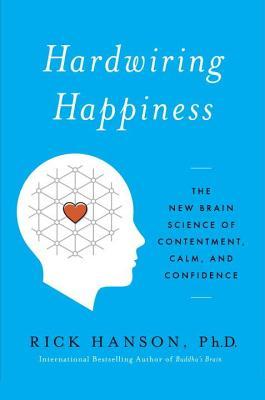Hardwiring Happiness Summary
7 min read ⌚
 The New Brain Science of Contentment, Calm, and Confidence
The New Brain Science of Contentment, Calm, and Confidence
What if you were not meant to be happy? What if your brain was programmed by evolution to be sad so that you have a better chance to survive the jungle of modernity?
Rick Hanson says: well, then we’ll just reprogram your brain. And our “Hardwiring Happiness” Summary features both his theories and his practical tips and tricks.
Who Should Read “Hardwiring Happiness”? And Why?
Most people see the glass as half empty – even when it’s full.
Why?
Because we’re all alike: we tend to focus on the negative. Neuroscience students can read “Hardwiring Happiness” to find out why. Regular folks should read it to find out how they can counter it. The optimists and the overall happy few out there – don’t really need any of our advice.
About Rick Hanson
Rick Hanson , Ph.D., is an American psychologist and a New York Times bestselling author. He graduated summa cum laude from UCLA, and he is currently a regular speaker at few major universities and NASA. He is also a senior fellow of the Greater Good Science Center at University of California, Berkeley.
, Ph.D., is an American psychologist and a New York Times bestselling author. He graduated summa cum laude from UCLA, and he is currently a regular speaker at few major universities and NASA. He is also a senior fellow of the Greater Good Science Center at University of California, Berkeley.
Hanson’s books have sold millions of copies and have been translated into more than thirty languages. In addition to “Hardwiring Happiness,” he is also the author of “Buddha’s Brain” and “The Neurodharma of Love.”
You can read more at http://www.rickhanson.net/.
“Hardwiring Happiness Summary”
Have you ever noticed how difficult it is to spend a whole day without having at least one negative thought?
No? Really?!
Well, then, probably you have what scientists unscientifically call “the happy amygdala.” In other words, that part of your brain which deals with emotional responses and decision-making processes is practically hardwired to focus on the good stuff.
Your computer breaks down while you’re working on your thesis and you lose a couple of hundred pages – hell, you say, repetition is the mother of learning! Your team loses in the NBA final after its opponents’ superstar drains a half-court shot in the last second – that was a great shot, you exclaim! And you are not even wondering whether a glass is half full or half empty! To you, the most important thing is that any glass is always fillable.
Needless to add, if you have a “happy amygdala,” you don’t need “Hardwiring Happiness”; you have biology on your side, and no book would ever beat that.
However – and unfortunately – most people have a “sad amygdala.” Which isn’t too kind to our bodies, releasing cortisol and adrenaline and other unhappy chemicals presumably at will. If you’re feeling anxious and edgy, well, take a number: you are just one among billions of unfortunate people hoodwinked by evolution.
And you do need “Hardwiring Happiness” to make things better.
Because, the good news is, your brain develops with every passing year – and you can steer its development in the direction you want the most. Biology and your early life didn’t result in your amygdala stimulating the nucleus accumbens?
Well, why don’t you start learning how you can do it yourself?
Take a lesson from the London cab drivers. According to a 2000 study by Eleanor Maguire, most of them have an overdeveloped area in their hippocampus. You’ve guessed it – it is the one most related to spatial memory.
So, the reason they remember streets much better than you is simple: they have unconsciously trained that part of the brain for years and years. What do you think will happen with your abs if you made at least a hundred sit-ups day in day out for twenty years straight?
Well, the same is true for your brain as well!
Then, why are so many people so sad and stressed out nowadays? How did they all manage to train their brains in such a misguided manner?
Once again, it’s got a lot to do with evolution. We – and we can’t overemphasize this fact – are the last in a long line of survivors. Basically, we are here because our ancestors were stressed out of their socks! And because if they hadn’t consistently focused on the bad stuff, they might have gotten the dirty end of evolution’s stick.
In other words, it wasn’t a good idea to be relaxed if there was a saber-toothed tiger in the cave a hundred meters away from you and your family! It was much better to be stirred up by even the slightest rustling of a leaf.
The problem?
Even though the danger is no more a tiger, but a deadline – your reaction has remained basically the same. That’s right: you are overreacting. By definition.
So what should you do to face this and put an end to your evolution-based inherent negativity bias?
What else: counter it with positivity. A lot and lot of positivity. As powerful as it is, “positive thinking is very superficial,” says Rick Hanson. You need to “take in the good,” that is internalize it deliberately in your implicit memory.
Really – almost anything will do. A nice dinner, a walk in the park, a discussion with a friend, a memory Experience it once again with all your senses. Savor it. Think about it every time you’re feeling bad.
Let’s just say that a few years from now, your amygdala will have a lot to thank you for.
Key Lessons from “Hardwiring Happiness”
1. It’s Not You: It’s Your Amygdala Which Is Sad
2. Internalize Positivity and Counter Your Negativity Bias
3. Take in the Good and Transform Your States into Traits
It’s Not You: It’s Your Amygdala Which Is Sad
It seems that at least few modern scientists believe that your sadness isn’t psychological, but biological. Namely, the amygdala – the part of your brain which deals with emotional responses, decision-making, and memory processing – has been trained by evolution to be negatively biased.
In other words: it stimulates you to think of the worst. That way, the worst can’t surprise you. This worked well in the early days of the homo sapiens when there were a lot of bad things that could happen to our ancestors basically each and every day. However, it doesn’t work well now when the worst thing that could happen to you is not anymore an attack by a mammoth, but a missed deadline.
The problem is that you and your Neanderthal great-great-great-granddaddy (yes – we know that we need to include few more of those “greats”…) are reacting in exactly the same way.
Who would have thought: you may be sad by design!
Internalize Positivity and Counter Your Negativity Bias
Let’s face it – it’s not a good thing to learn that evolution built you sad. And we don’t need scientists who tell us that, right? We may have been better off without knowing this.
Well, Rick Hanson doesn’t think that way. In fact, he claims that once we learn this, we can finally start being happy. Because we just need to retrain our brain.
And the best way to counter the negativity bias we’ve inherited from our distant ancestors?
Happy thoughts. And not just positive thinking – Hanson says it’s too superficial. You need to act much more profoundly and internalize the positive thinking, transforming it into an inherent part of your memory.
How?
Just remember this acronym and stick blindly to it: HEAL. It stands for: having positive experiences; then enriching them; next absorbing them; and, finally, linking them with the negative material so that you can overwrite the latter.
Take in the Good and Transform Your States into Traits
What we just described above is Hanson’s elaboration on the idea of “taking in the good.”
Its central element is actually quite simple: take some time to enjoy the happy moments of your life. Experience them. Savor them. Don’t let them pass by you just because that’s in their nature.
Remember: your goal is to transform these “fleeting mental events to lasting neural structure;” or, in layman’s terms, to go from the few brief happy states of your existence into permanent traits of your character.
It takes a lot of work to do this. But, you can do it.
After all, it’s your happiness we’re talking about.
Like this summary? We’d like to invite you to download our free 12 min app, for more amazing summaries and audiobooks.
“Hardwiring Happiness” Quotes
By taking just a few extra seconds to stay with a positive experience—even the comfort in a single breath—you’ll help turn a passing mental state into lasting neural structure. Share on X Neurons that fire together wire together. Mental states become neural traits. Day after day, your mind is building your brain. This is what scientists call experience-dependent neuroplasticity. Share on X The brain is good at learning from bad experiences, but bad at learning from good ones. Share on X Mammals, including us, become friendly, playful, curious, and creative when they feel safe, satisfied, and connected. Share on X Even if you, like me, have done things worthy of remorse, they do not wipe out your good qualities; you are still a fundamentally good person. Share on XOur Critical Review
After remarking that “if we understand the brain a little, we can take care of our lives a lot,” Mark Hanson, a Professor at the University of Oxford, wrote that “Hardwiring Happiness” is “a book to savor, to practice, and to take to heart.”
And, obviously, a lot is happening here: few interesting scientific theories, some even more fascinating studies, and numerous practical advices which may make a real difference to your wellbeing. However, the book feels a bit repetitive, and we feel that we agree completely with one Amazon reviewer who describes it succinctly as “40 pages of good info stretched out to 300.”
Emir is the Head of Marketing at 12min. In his spare time, he loves to meditate and play soccer.


 The New Brain Science of Contentment, Calm, and Confidence
The New Brain Science of Contentment, Calm, and Confidence 




